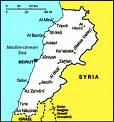Fighting Erupts in Lebanon: US, Israeli, and Saudi-funded terrorists destabilizing Syria now under fire in Lebanon

According to a 2007 New Yorker article by Seymour Hersh, “The Redirection,” the US, Israel, and Saudi Arabia had been assembling a region-wide army of extremist-mercenaries to battle Hezbollah in Lebanon, destabilize and overthrow Syria, and create a united front against Iran. The forces recruited for this effort would come from the ranks of the CIA-created “Arab foreign legion,” Al Qaeda itself – extremist groups fresh back from fighting US troops in Iraq and Afghanistan, including listed terror organizations like the Libyan Islamic Fighting Group (LIFG) from Libya.
Hersh’s 2007 report exposed the groundwork for the very violence unfolding in Syria today, and now Lebanon. Forces to destabilize Syria were primarily to be staged in northern Lebanon, as explained in the article, and indeed the heaviest fighting over the last year has been seen in the Syrian city of Homs, just across the border from northern Lebanon. Syria’s President Bashar al-Assad and his government have been, since the beginning of the violence, attempting to illustrate just this – explained in detail in 2007, and demonstratively being carried out today, with responsibility for deadly bombings being claimed by terrorists, the Pentagon itself admitting Al Qaeda is present in Syria, and reports indicating foreign fighters, weapons, and cash are flowing over Syria’s borders.
Lebanon’s Turn?
Now, the very staging ground in northern Lebanon being used to destabilize neighboring Syria has erupted into violence. Not by Syrian troops crossing the border, but by indigenous Lebanese factions facing off against each other. News is trickling out slowly and the Western media appears intent on keeping the violence as nebulous and confused as possible, but initial information indicates that extremist groups backed by the US, Israel, and Saudi Arabia are fighting factions connected to Hezbollah. Extremist leaders across the region are attempting to frame the violence as “Sunni verses Shi’ia,” a ploy Hezbollah leader Hassan Nasrallah warned against back in 2007:
“Nasrallah accused the Bush Administration of working with Israel to deliberately instigate fitna, an Arabic word that is used to mean “insurrection and fragmentation within Islam.” “In my opinion, there is a huge campaign through the media throughout the world to put each side up against the other,” he said. “I believe that all this is being run by American and Israeli intelligence.” (He did not provide any specific evidence for this.) He said that the U.S. war in Iraq had increased sectarian tensions, but argued that Hezbollah had tried to prevent them from spreading into Lebanon. (Sunni-Shiite confrontations increased, along with violence, in the weeks after we talked.)” –The Redirection, Seymour Hersh
Far from genuine sectarian violence, it was planned since 2007, to use terrorist proxies in a battle stretching from Lebanon to Iran with Arab nations from North Africa to the Middle East aiding the effort, dominated by freshly installed US proxies (Tunisia & Libya) and the Muslim Brotherhood, stated in Hersh’s 2007 article to be wards of the West.
Violence has raged for nearly a week, in and around Lebanon’s northern port city of Tripoli. While being depicted as violence “spilling over” from Syria, it is clear that the violence is indigenous, sectarian in nature, and directly related to the larger conflict envisioned by US-Israeli-Saudi machinations in 2007 – pitting Sunnis against Shi’ia. An editorial from NOW Lebanon reveals the “sectarian” nature of the violence in Lebanon and how both sides identify as either supporters or opponents of the neighboring Syrian government.
This prevailing “sectarian” aspect reveals what has been stated by geopolitical analysts since the beginning of unrest in Syria – that the violence was driven not by “pro-democratic” aspirations, but by sectarian violence exploited for the sole purpose of advancing the agenda of foreign meddlers – sectarian violence that has now manifested itself in attacks on Christians, Druze, and Alawites, as well as moderate Sunnis across Syria in the midst of this so-called “democratic revolution.”
The sectarian violence now unfolding in Tripoli is not unheard of in Lebanon. The Lebanese military has already been reportedly deployed but is sitting on the sidelines as factions war in the streets. The violence may ebb, as it has in the past, but with the Syrian unrest reaching a critical point and foreign powers desperate to change momentum that’s been working against them, foreign-backed terrorist forces could try to ignite a wider sectarian battle in Lebanon. This could be to paralyze Hezbollah ahead of either a coup de grâce delivered to Syria by Turkey, or to simply inflame the entire region in conflict, making the movement of weapons, cash, and foreign support to proxy forces easier to move around, as well as grease the skids for introducing a Kosovo-style intervention.
Regardless, “sectarian” differences between Sunni and Shi’ia Muslims were planned for exploitation since at least as early as 2007 by the US, Israel, and Saudi Arabia, for the sole purpose of advancing their self-serving hegemonic agendas throughout the region. The violence that both sides are playing into will deprive their communities of the security and stability needed for all to prosper and progress, and ultimately leave them at the mercy of foreign dominion.


